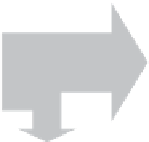Environmental Engineering Reference
In-Depth Information
Electrical
output
P
s
Mechanical
input
P
air gap
P
m
P
r
Stator
Cu + iron
losses
Rotor Cu
loss
Power through
the slip rings
Figure 3.20
DFIG power relationships
From (3.17) and (3.18), the stator power
P
s
is expressed by
P
s
¼
P
m
P
r
ð
3
:
19
Þ
Equation (3.19) can be written in terms of the generator torque,
T
,as
T
w
s
¼
T
w
r
P
r
ð
3
:
20
Þ
where
P
s
¼
T
w
s
and
P
m
¼
T
w
r
. Rearranging terms in (3.20),
P
r
¼
T
ðw
s
w
r
Þ
ð
3
:
21
Þ
The stator and rotor powers can then be related through the slip
s
as
P
r
¼
sT
w
s
¼
sP
s
ð
3
:
22
Þ
where
s
is given in terms of
w
s
and
w
r
as
s
¼
ð
w
s
w
r
Þ
w
s
ð
3
:
23
Þ
Combining (3.19) and (3.22) the mechanical power,
P
m
, can be expressed as
P
m
¼
P
s
þ
P
r
¼
P
s
sP
s
¼ð
1
s
Þ
P
s
ð
3
:
24
Þ
The total power delivered to the grid,
P
g
, is then given by
P
g
¼
P
s
þ
P
r
ð
3
:
25
Þ
The controllable range of
s
determines the size of the converters for the DFIG.
Mechanical and other restrictions limit the maximum slip and a practical speed
range may be between 0.7 and 1.1 pu.














Search WWH ::

Custom Search